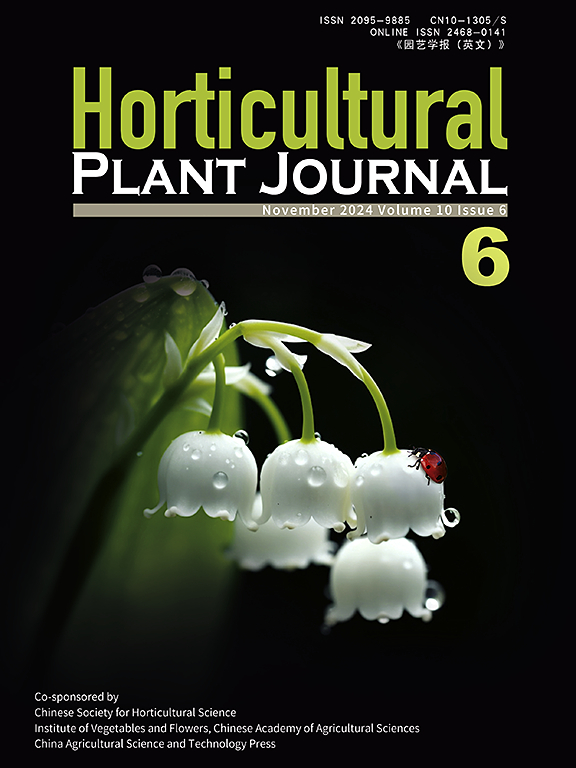转录组分析为一年两茬栽培制度下的 "夏黑 "葡萄浆果大小提供了新见解
IF 5.7
1区 农林科学
Q1 HORTICULTURE
引用次数: 0
摘要
中国南方气温高,降雨集中,因此葡萄生产采用一年两季的栽培方式,以解决葡萄产量季节性相对过剩的问题。然而,该技术的一个普遍问题是第二季果实往往比第一季果实小。在此,我们以不同成熟期的 "夏黑 "第一季和第二季果实为研究材料。表型学和组织学分析表明,花后 7 至 14 天(DPA)期间,第二季果实细胞数量减少,最终导致果实大小小于第一季果实。为了揭示这一现象的内在机理,我们选择了第一季和第二季四个时期(花后 7、14、21 和 28 天)的果实进行 RNA 序列分析。这项分析确定了 10 431 个差异表达基因(DEG)。通过 GO 和 KEGG 富集分析,这些 DEGs 被分为 9 个群组。然后,利用广度优先搜索算法进行的时间排序基因共表达网络(TO-GCN)分析表明,GCN 中的 DEGs 被分为 8 个层次。浆果发育早期(L1-L3)的 DEGs 富集于热胁迫和细胞分裂相关通路。对有效积温的实地调查证实,在7-14 DPA期间,第二季果实的生长发育受到了高温胁迫。此外,基于TO-GCN和L1-L3基因转录调控预测的交互分析结果,我们构建了一个独特的热胁迫调控浆果大小的分层调控网络。通过 qRT-PCR 验证了 5 个候选基因的表达水平。(在 7-14 DPA 期,()、()、()、()和()被上调,而()在 7 DPA 期被下调。这些结果表明,在细胞激烈分裂过程中,热胁迫可能是导致细胞数量减少的主要因素,从而最终导致第二季果实体积变小。本文章由计算机程序翻译,如有差异,请以英文原文为准。
Transcriptome analysis provides new insights into the berry size in ‘Summer Black’ grapes under a two-crop-a-year cultivation system
Southern China has high temperatures and receives concentrated rainfall; therefore, the two-crop-a-year cultivation system has been applied to grape production so as to resolve the problem of relative seasonal surplus of grape yield. However, a common issue associated with this technique is the tendency of the second season fruits to be smaller than the first season fruits. We here used the first and second season fruits of ‘Summer Black’ at different ripening stages as research materials. Phenotypic and histological analyses revealed fewer cell number occurring between 7 and 14 days post anthesis (DPA) in the second season fruits, which ultimately resulted in a smaller fruit size compared with the first season fruits. To unravel the mechanism underlying this phenomenon, first and second season fruits of four time periods (7, 14, 21, and 28 DPA) were selected for RNA-seq analysis. This analysis identified 10 431 differentially expressed genes (DEGs). These DEGs were classified into 9 clusters through GO and KEGG enrichment analyses. Then the time-ordered gene co-expression network (TO-GCN) analysis with the breadth-first search algorithm showed that DEGs in the GCN were divided into 8 levels. The DEGs of early berry development (L1–L3) were enriched in heat stress- and cell division-related pathways. The field investigation of effective accumulated temperature confirmed that the growth and development of the second season fruits were subjected to high temperature stress during 7–14 DPA. Moreover, based on the results of interactive analysis of TO-GCN and transcriptional regulation prediction of L1–L3 genes, we constructed a unique hierarchical regulatory network for the heat stress regulation of berry size. The expression level of 5 candidate genes was verified through qRT-PCR. (), (), (), (), and () were upregulated in 7–14 DPA, whereas () was downregulated in 7 DPA. These results suggest that during intense cell division, heat stress might act as a major factor causing a reduction in cell number, thereby ultimately resulting in the smaller size of the second season fruits.
求助全文
通过发布文献求助,成功后即可免费获取论文全文。
去求助
来源期刊

Horticultural Plant Journal
Environmental Science-Ecology
CiteScore
9.60
自引率
14.00%
发文量
293
审稿时长
33 weeks
期刊介绍:
Horticultural Plant Journal (HPJ) is an OPEN ACCESS international journal. HPJ publishes research related to all horticultural plants, including fruits, vegetables, ornamental plants, tea plants, and medicinal plants, etc. The journal covers all aspects of horticultural crop sciences, including germplasm resources, genetics and breeding, tillage and cultivation, physiology and biochemistry, ecology, genomics, biotechnology, plant protection, postharvest processing, etc. Article types include Original research papers, Reviews, and Short communications.
 求助内容:
求助内容: 应助结果提醒方式:
应助结果提醒方式:


